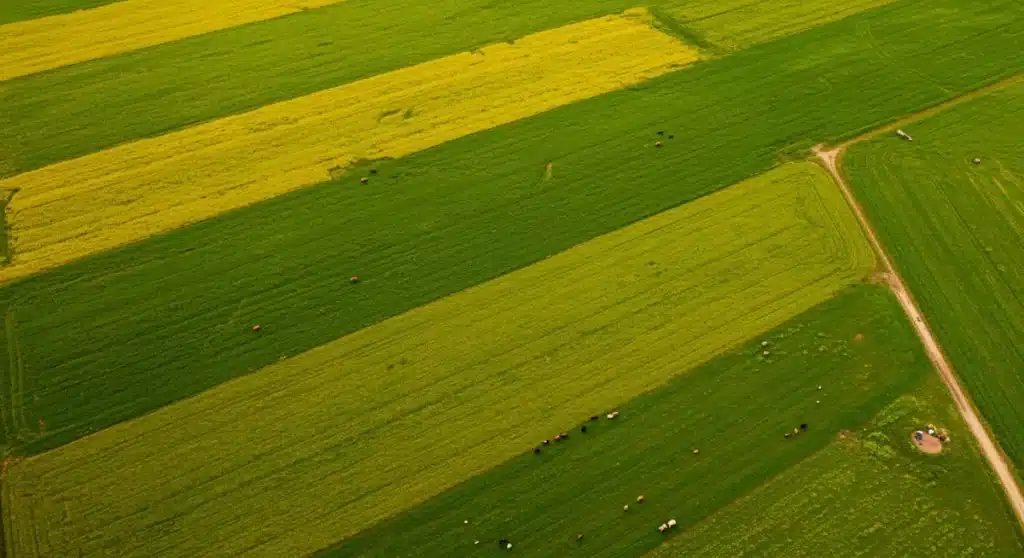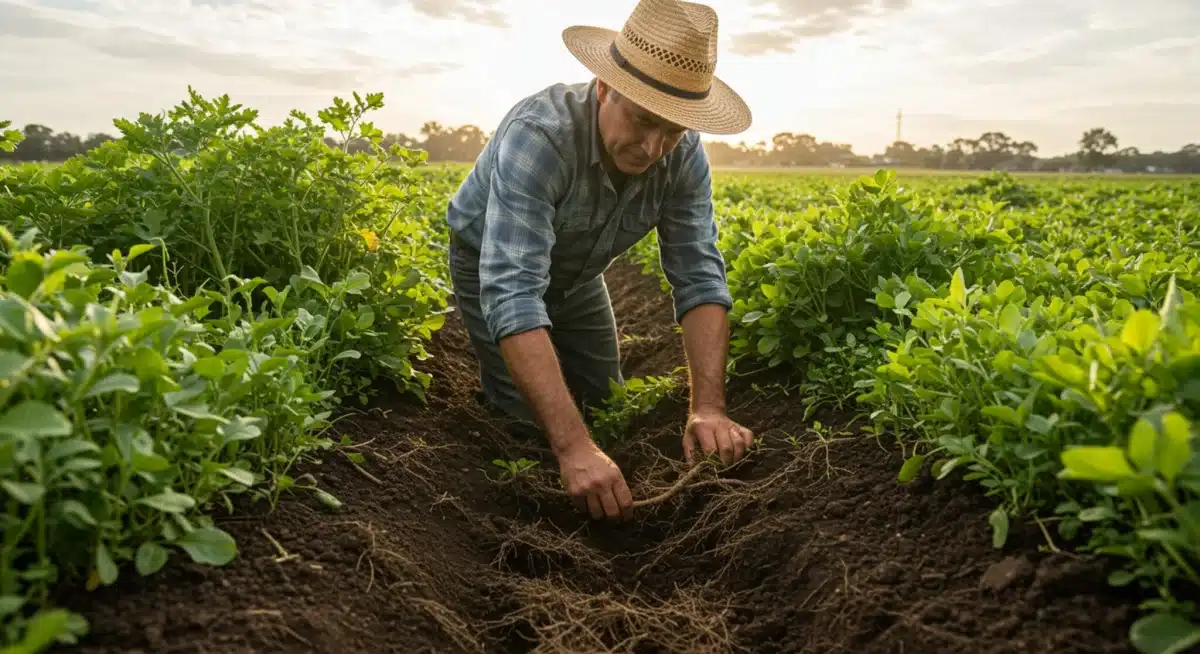Regenerative Agriculture: US Farmers Combat Climate Change

Regenerative agriculture in the US is swiftly becoming a cornerstone strategy, empowering farmers with innovative methods to combat climate change, improve soil vitality, and bolster agricultural resilience.
As the urgency of environmental stewardship grows, Regenerative Agriculture: How US Farmers are Using Innovation to Combat Climate Change is not just a buzzword, but a vital pathway towards a more sustainable future. This approach, deeply rooted in ecological principles, offers a compelling solution to some of the most pressing challenges facing our planet, directly impacting the resilience of our food systems.
The foundational principles of regenerative agriculture
Regenerative agriculture represents a paradigm shift in farming, moving beyond mere sustainability to actively restore and enhance ecosystems. It’s a holistic land management system that aims to reverse environmental degradation by focusing on soil health, biodiversity, and water quality. This approach recognizes the interconnectedness of all elements within an agricultural system, emphasizing practices that work with nature rather than against it.
At its core, regenerative agriculture seeks to improve the health and vitality of the soil, understanding that healthy soil is the bedrock of a productive and resilient farm. By fostering robust microbial communities and increasing organic matter, regenerative practices enhance the soil’s capacity to sequester carbon, retain water, and provide nutrients to plants naturally. This reduces the reliance on synthetic inputs, leading to more sustainable and economically viable farming operations.
Key pillars of regenerative farming
Several core principles guide regenerative agricultural practices, forming a comprehensive framework for ecological restoration and agricultural productivity.
- Minimizing soil disturbance: Practices like no-till or reduced-till farming protect soil structure, prevent erosion, and preserve beneficial microbial networks essential for nutrient cycling.
- Maximizing crop diversity: Incorporating diverse crop rotations, cover cropping, and intercropping enhances biodiversity, suppresses pests, and improves soil fertility, leading to more resilient agricultural systems.
- Keeping the soil covered: Maintaining living roots in the soil year-round through cover crops or perennial plants protects against erosion, feeds soil microbes, and improves water infiltration.
- Integrating livestock: Thoughtfully managed grazing can stimulate plant growth, enhance nutrient cycling, and distribute organic matter, mimicking natural ecosystem processes.
- Minimizing synthetic inputs: Reducing reliance on synthetic fertilizers and pesticides fosters natural biological processes, supporting a healthier soil microbiome and reducing environmental pollution.
These principles, when applied collectively, initiate a virtuous cycle of ecological restoration. Farmers witness improvements in soil structure, water retention, and nutrient availability, which in turn leads to healthier crops and livestock. This integrated approach not only benefits the environment but also provides economic advantages through reduced input costs and enhanced crop resilience.
US farmers embracing no-till and cover cropping
In the United States, a growing number of farmers are adopting no-till and cover cropping practices, recognizing their immense benefits for soil health and environmental sustainability. These methods are at the forefront of regenerative agriculture, offering practical solutions to combat soil degradation and enhance farm productivity. By minimizing soil disturbance and maintaining continuous living roots, farmers are transforming their fields into thriving ecosystems.
No-till farming involves planting crops directly into the residue of previous crops without plowing or tilling the soil. This practice helps to preserve soil structure, prevent erosion, and increase organic matter content. The undisturbed soil acts as a sponge, improving water infiltration and retention, which is crucial in regions prone to drought or heavy rainfall. Farmers report significant reductions in fuel consumption and labor costs, making their operations more efficient and profitable.


The power of cover crops
Cover crops, planted between cash crop cycles, play a pivotal role in regenerative systems. They protect the soil from erosion, suppress weeds, and add organic matter. Furthermore, leguminous cover crops can fix atmospheric nitrogen, reducing the need for synthetic nitrogen fertilizers, which are energy-intensive to produce and can contribute to greenhouse gas emissions.
- Erosion control: Cover crops create a protective layer over the soil, preventing wind and water erosion, especially during periods when cash crops are not growing.
- Weed suppression: Their dense growth outcompetes weeds for light, water, and nutrients, reducing the need for herbicides.
- Nutrient cycling: Cover crops scavenge residual nutrients from the soil, preventing them from leaching, and release them back for the subsequent cash crop as they decompose.
- Soil organic matter: Their biomass contributes to increasing soil organic matter, improving soil structure, water holding capacity, and microbial diversity.
The combination of no-till and cover cropping creates a powerful synergy that revitalizes agricultural land. Farmers who implement these practices often observe a noticeable improvement in soil health within just a few years, leading to more resilient crops that are better equipped to withstand environmental stresses. This approach not only benefits the environment but also enhances the long-term productivity and profitability of farms across the US.
Rotational grazing and integrated livestock management
Rotational grazing, a cornerstone of regenerative agriculture, involves moving livestock systematically across pastures to optimize forage growth and soil health. This practice mimics natural grazing patterns observed in wild ecosystems, where herds frequently move to new areas, allowing previously grazed land to recover and regenerate. Integrated livestock management takes this a step further by thoughtfully incorporating animals into cropping systems, creating a more diverse and resilient farm ecosystem.
The benefits of rotational grazing are multifaceted. By preventing overgrazing, it allows plants to fully recover, leading to deeper root systems and increased biomass. This, in turn, enhances carbon sequestration, improves water infiltration, and fosters a richer soil microbiome. Manure and urine distribution by grazing animals naturally fertilize the soil, reducing the need for synthetic inputs and closing nutrient loops on the farm.
Benefits of strategic livestock integration
Integrating livestock into cropping systems offers unique advantages that go beyond traditional grazing. Animals can graze cover crops, turning plant biomass into valuable organic matter and nutrients, while simultaneously preparing fields for the next cash crop. This symbiotic relationship enhances the overall productivity and sustainability of the farm.
- Enhanced soil fertility: Livestock manure enriches the soil with organic matter and essential nutrients, boosting microbial activity and plant growth.
- Weed and pest control: Grazing animals can effectively manage weeds and crop residues, reducing reliance on chemical controls.
- Biodiversity boost: The presence of diverse forage plants and animal activity supports a wider range of beneficial insects and wildlife, contributing to overall ecosystem health.
- Carbon sequestration: Healthy pastures managed through rotational grazing are highly effective at capturing and storing atmospheric carbon in the soil.
US farmers utilizing these integrated approaches are not only seeing healthier animals and more productive pastures but also experiencing significant improvements in soil health indicators. The strategic movement of livestock becomes a powerful tool for land regeneration, demonstrating how ancient wisdom, combined with modern understanding, can create highly effective, climate-friendly agricultural systems. This synergy between crops and animals is vital for building truly regenerative farms.
Water management and biodiversity in regenerative systems
Effective water management and the promotion of biodiversity are critical components of regenerative agriculture, offering powerful solutions to environmental challenges. Regenerative practices aim to enhance the land’s natural capacity to absorb, store, and filter water, while simultaneously creating habitats that support a wide array of plant and animal life. These interconnected goals contribute significantly to the resilience of agricultural landscapes in the face of climate change.
By improving soil structure and increasing organic matter content, regenerative farms transform into sponges that can hold more water. Practices such as cover cropping, no-till, and the integration of perennial plants reduce runoff and erosion, allowing more water to infiltrate the soil profile. This not only conserves water resources but also helps mitigate the impacts of both droughts and floods, providing greater stability for crops and ecosystems.
Fostering ecological balance
Biodiversity is the lifeblood of a healthy ecosystem, and regenerative agriculture prioritizes its restoration and enhancement. By diversifying crops, integrating livestock, and establishing natural buffer zones, farmers create environments that support a rich tapestry of life, from beneficial insects and pollinators to birds and soil microorganisms.
- Pollinator habitats: Planting diverse flowering cover crops and native plants provides essential food and shelter for pollinators, crucial for crop production.
- Beneficial insect populations: A varied farm ecosystem attracts natural predators of agricultural pests, reducing the need for synthetic pesticides.
- Soil microbiome enhancement: Diverse plant roots and organic matter inputs foster a rich and complex community of soil microbes, essential for nutrient cycling and soil health.
- Water quality protection: Healthy riparian buffers and reduced reliance on chemical inputs prevent agricultural runoff from contaminating waterways, safeguarding aquatic ecosystems.
US farmers who adopt these biodiversity-centric and water-wise practices are not just growing food; they are actively cultivating thriving ecosystems. This holistic approach ensures that farms are not only productive but also contribute positively to the surrounding environment, creating robust systems that are better equipped to adapt to the unpredictable challenges posed by a changing climate. The focus on water and biodiversity makes regenerative agriculture a truly sustainable path forward.
Economic incentives and policy support for adoption
The widespread adoption of regenerative agriculture in the US is increasingly supported by a combination of economic incentives and evolving policy frameworks. Recognizing the long-term benefits of these practices for both environmental health and agricultural resilience, various stakeholders are working to make regenerative farming more accessible and profitable for farmers. This support is crucial for overcoming initial investment barriers and encouraging a broader transition.
Farmers who transition to regenerative practices often experience reduced input costs over time, as their reliance on synthetic fertilizers, pesticides, and irrigation diminishes. Improved soil health leads to more stable yields, even in challenging weather conditions, enhancing financial security. Furthermore, some markets are beginning to offer premium prices for products grown using regenerative methods, providing an additional revenue stream.


Government programs and private initiatives
Both federal and state governments in the US are introducing programs to support regenerative agriculture. These initiatives often provide financial assistance, technical guidance, and educational resources to farmers interested in making the transition.
- USDA conservation programs: Programs like the Environmental Quality Incentives Program (EQIP) and the Conservation Stewardship Program (CSP) offer financial and technical assistance for adopting conservation practices, including many regenerative techniques.
- State-level incentives: Several states provide their own grants, tax credits, and cost-share programs to encourage practices such as cover cropping, no-till, and rotational grazing.
- Private sector investment: Food companies and foundations are investing in regenerative supply chains, offering incentives to farmers who meet specific regenerative criteria, driven by consumer demand for sustainably produced food.
- Carbon markets: Emerging carbon markets offer potential revenue for farmers who sequester carbon in their soils through regenerative practices, creating a new income stream for environmental stewardship.
These policy and economic incentives are vital for accelerating the transition to regenerative agriculture. By reducing financial risks and providing clear pathways for adoption, they empower US farmers to invest in practices that benefit their land, their livelihoods, and the planet. The growing recognition of regenerative agriculture’s value is paving the way for a more resilient and sustainable food system.
Challenges and future outlook for regenerative agriculture
While the promise of regenerative agriculture is significant, its widespread adoption in the US faces several challenges. Overcoming these hurdles will be crucial for realizing the full potential of these innovative practices in combating climate change and building a more resilient food system. Farmers, policymakers, and researchers are actively working to address these issues, paving the way for a more sustainable agricultural future.
One primary challenge is the initial learning curve and perceived risk associated with transitioning from conventional farming methods. Regenerative practices often require a shift in mindset and management techniques, and the benefits may not be immediately apparent. Access to reliable information, peer support, and qualified technical assistance is essential to help farmers navigate this transition successfully.
Pathways to broader adoption
Despite the challenges, the future outlook for regenerative agriculture in the US is increasingly positive, driven by growing awareness, scientific advancements, and collaborative efforts.
- Education and outreach: Expanding access to practical training, demonstration farms, and farmer-to-farmer networks can accelerate knowledge transfer and build confidence.
- Research and development: Continued investment in scientific research is needed to quantify the benefits of regenerative practices, develop region-specific solutions, and refine management strategies.
- Supply chain integration: Greater collaboration between farmers, food processors, retailers, and consumers can create stronger demand and more stable markets for regeneratively produced goods.
- Policy innovation: Further development of supportive policies, including financial incentives, risk management tools, and streamlined certification processes, will be key to scaling adoption.
The journey towards a fully regenerative agricultural landscape in the US is ongoing, but the momentum is undeniable. As more farmers experience the ecological and economic benefits firsthand, and as supportive frameworks continue to evolve, regenerative agriculture is poised to become a dominant force in sustainable food production. The collective effort to overcome current challenges will ultimately determine how quickly and effectively these innovative practices can transform our agricultural systems for the better, securing a healthier planet for future generations.
| Key Practice | Benefit for Climate Change |
|---|---|
| No-Till Farming | Reduces soil carbon release and improves carbon sequestration. |
| Cover Cropping | Enhances soil organic matter, sequesters carbon, and reduces nutrient runoff. |
| Rotational Grazing | Improves pasture health, increases carbon storage, and reduces methane emissions. |
| Increased Biodiversity | Builds ecosystem resilience, supports natural pest control, and improves water cycling. |
Frequently asked questions about regenerative agriculture
The primary goal of regenerative agriculture is to restore and enhance ecosystem health, particularly soil health, while producing food, fiber, and fuel. It aims to reverse climate change by rebuilding soil organic matter and biodiversity, leading to increased carbon sequestration and improved water cycles.
Regenerative agriculture combats climate change by increasing the soil’s capacity to sequester atmospheric carbon dioxide, reducing greenhouse gas emissions from conventional farming practices, and enhancing the resilience of agricultural systems to extreme weather events. Healthier soils act as significant carbon sinks.
Yes, many US farmers find regenerative methods profitable in the long term. While initial transition costs exist, reduced reliance on synthetic inputs, improved soil fertility, increased water retention, and potential access to premium markets often lead to greater financial stability and profitability over time.
Cover crops are crucial for regenerative agriculture. They protect soil from erosion, suppress weeds, enhance soil organic matter, improve nutrient cycling, and provide continuous living roots that feed the soil microbiome, significantly boosting overall soil health and farm resilience.
Consumers can support regenerative agriculture by seeking out products labeled as regeneratively grown, purchasing directly from local farmers who practice these methods, and advocating for policies that incentivize sustainable farming. Educating oneself and others about its benefits also plays a vital role.
Conclusion
Regenerative agriculture is not merely an alternative farming method; it represents a fundamental shift towards a more harmonious relationship between agriculture and the environment. US farmers, through their innovative adoption of practices such as no-till, cover cropping, and rotational grazing, are demonstrating that food production can actively contribute to climate change solutions. By focusing on soil health, enhancing biodiversity, and optimizing natural processes, these farmers are building resilient agricultural systems that are better equipped to withstand environmental challenges and secure a sustainable future for generations to come. The continued growth and support for regenerative agriculture hold immense promise for both our planet and our food security.





